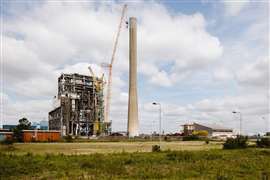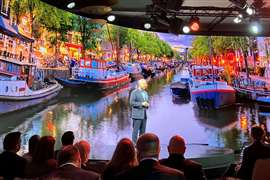High-rise construction - raising the bar
09 November 2010

Opened in January this year the 163 storey Burj Khalifa has been ratified by the Council on Tall Buildings and Urban Habitat (CTBUH) as the world's tallest building. At 828 m in height it sails past the previous holders, Taiwan's 509.2 m tall Taipei 101 and the 527 m tall Willis Tower (formerly known as the Sears Tower) in Chicago, US.
In raising the bar, the Burj Khalifa has become the 16th building to hold the title of 'World's Tallest' and stands an additional 773 m, or 15 times taller, than the world's first 'tall building' - the Home Insurance Building completed in Chicago, US in 1885.
Structural Partner at Skidmore, Owings and Merrill (SOM), Bill Baker told iC, "I think we'll have 1 km tall towers within a decade. I believe the Burj Khalifa represents a paradigm shift as it addresses high rise issues and provides a good structural system for constructing super-tall buildings."
Mr Baker led the architectural, structural design and engineering teams behind the Burj Khalifa and is uniquely placed to comment on the tower's significance. "It's a shift from the old towers such as the Willis (527 m) and Hancock (344 m), which used structural systems that were really at the limit of their capability. Beyond 600 m you have to use a different system - it becomes a matter of issues of scale," he said.
To this end he said that a key issue was not having too much floor area. "If you made the Willis Tower over 600 m tall you'd have almost 1.1 million m2 of floor space in a single building. It's unmarketable," he said.
While it's helpful to increase the footprint of a super high rise, it has to be done in a way that doesn't create really deep, unusable space according to Mr Baker. "The base of the Sears Tower consists of nine cells, so at the base the distance from the window to the back wall, or core, is 22.5 m. That's a long way from the window! With the Burj Khalifa, the maximum distance from window to core is about 11 m," he said.
According to communications manager at CTBUH, Jan Klerks, the Burj Khalifa uses relatively straightforward techniques to ensure the building stands up. "The tower is built of concrete with embedded steel plates up to floor 156. From there, a lighter steel structure takes over all the way to the top.
"Usually a tower has a rectangular plan, but such a plan would not have worked for the desired height of the Burj Khalifa. By designing a Y-shaped structural plan, one wing buttresses the other two wings," he said.
Mr Baker told iC, "If you look at the Burj Khalifa the building gets bigger as it goes down towards the base. As the building accumulates both wind loads and gravity loads the shaft gets larger and larger, so when it hits the ground the pressure imparted on the soil is not that different to a normal building because the footprint has grown so much."
Loads
Americas building practice leader at Arup and vice chairman of CTBUH, David Scott told iC, "As wind goes around a building it creates vortices. These are a function of the width of the building. If a building is a constant width going up, then you get an enormous vortex coming off the side of the building, which pushes the building over in a direction 900 to the wind."
Mr Scott said that what was done on the Burj Khalifa to counter this was to keep changing the height of the building as the tower climbed so as it went up different size vortices were created for the whole of the building. "This prevented a massive load occurring at once, which would have otherwise placed enormous stress on the building," he said.
The designs of the leading and trailing edges of the building are also very important according to Mr Scott. "All of these systems were looked at during the design of the Burj Khalifa. It's quite a common design process to look at the leading edge issues to change the wind profile with height to get rid of the vortex," he said.
Mr Baker said that on the Burj Khalifa SOM used the wind tunnel as a design tool rather than just using it to show an immovable set of numbers.
"When we received our first set of wind data, it became quite clear that we needed to change the shape of the building to address various issues. The first thing we did was to adjust the setbacks from being counter-clockwise to being clockwise and then rotated the building through 1200 because one wind direction was more lively than the others.
"Eventually, we modelled the building to such a degree that the wind effect become so quiet we didn't even need a damping system," he said.
Beneath the main tower of the Burj Khalifa the structure sits on 196 piles, each 1.5 m in diameter and each sunk 47.5 m into subsoil that consists of a 10 m deep layer of calcareous sand covering a mixed formation of rocks.
The outer podium sits on a further 750 piles of 900 mm in diameter sunk to a depth of 30 m and the entire structure sits on a concrete raft, which is 3.7 m thick directly beneath the tower.
Elevators
While constructing super-tall buildings is both structurally and technically demanding, the movement of people in the finished towers was previously thought to be a defining factor in how tall we can go. Indeed, the Burj Khalifa is at the limit of current elevator technology. "We have an elevator that travels approximately 500 m, but people and goods then need to transfer to a separate elevator to go above this height," said Mr Baker.
Across the Atlantic, elevators are playing a leading role in construction of the Shard of Glass in London, UK. The 310 m tall, UK£ 430 million (US$ 670 million) tower at London Bridge station being developed by Sellar Property Group will be the tallest building in the country once completed in May 2012.
Senior construction manager for main contractor Mace Construction, Peter Savoy said, "I think that people and material movement is probably the most critical element of this project. To this end we have a fairly robust lift and hoist strategy.
"Kone is building jump lifts for the project. This means they start building the lifts before the shaft is complete. We get to a certain level and below the Byrne Brothers slipform - which is climbing the core - we put in cross decks and install a mobile lift motor room. This enables us to protect the permanent lift and get it operational early.
"Thanks to the jump lifts, at wind speeds above 61 km/h we can stop the two Alimak Hek hoists and five Terex Comedil tower cranes but continue construction inside the building. This gives us the ability to maintain the movement of materials and people around the project, which is critical, especially as we get higher up the building."
Mace has four jump lifts in operation on the Shard of Glass, which Mr Savoy said gave adequate cover regardless of wind and weather.
Another innovative approach at the Shard of Glass can be found in the construction of the three-level basement. "We applied a top-down construction method for the basement, which enabled us to accelerate the pace of work in comparison to a more traditional bottom-up method," said Mr Savoy. "For the foundations and basement we excavated nearly 61000 m3 of material, which was either recycled or sent to landfill," he said.
As the Shard of Glass climbs into the London skyline Mace has developed a double-height edge protection system with Combisafe. As well as the 1.8 m high mesh perimeter protection, nets engineered to withstand wind speeds of up to 160 km/h drop down from the last poured slab to within 500 mm of the ground to provide total cover.
A purpose built Byrne Brothers slipform rig is being used to form the 250 m high core of the tower. Project manager for Byrne Brothers, Don Houston told iC, "We're already at level 38, so we're about half way up.
"The three-level rig we've designed uses lightweight steel facings and has a 26 m x 22 m plan area. As well as the core we are also forming the floor slabs. Up to level 39 the floors comprise a concrete-steel-concrete sandwich, but above floor 40 the slabs will be post-tensioned and for this we will use an Ischebeck Titan system," he said.
Mr Savoy told iC that there is also a lot of work going on in the area of securing tools and equipment either to the structure or to the operative while he's working. "The technology isn't quite advanced enough yet to enable us to tether absolutely everything, but we are working closely with manufacturers to develop new tools that can be tethered and still do the job they are required to do," he said.
Forwards
The future of high rise buildings continues to be bright. As Mr Scott told iC, "People need cities to be vibrant, interesting, exciting and tall and we want people to live in cities rather than spreading out over the whole of the countryside. I very much see tall buildings as being a part of the vibrant urban fabric of the future.
STAY CONNECTED


Receive the information you need when you need it through our world-leading magazines, newsletters and daily briefings.
CONNECT WITH THE TEAM










